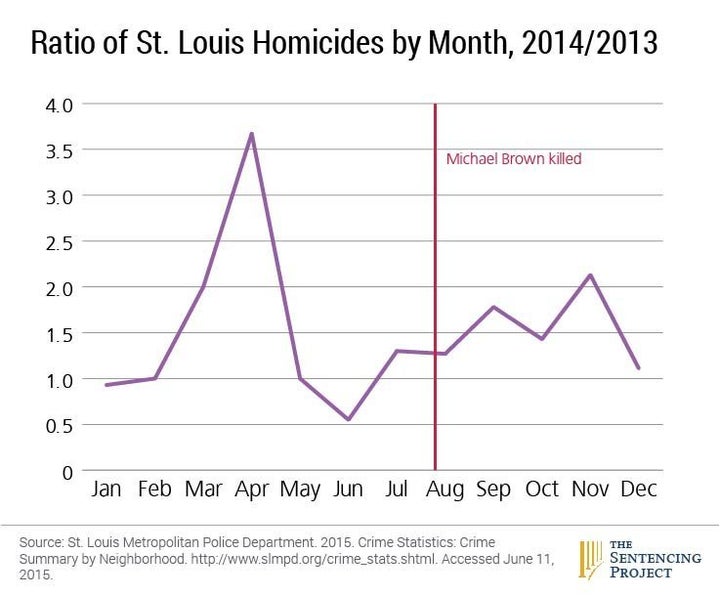
On Monday, The New York Times published an article on murder rates that was misleading at best, and fearmongering at worst.
"Murder Rates Rising Sharply in Many U.S. Cities," the headline screamed.
The lede was just as alarming. It spoke of "a startling rise in murders" this year in cities "across the nation," chief among them Milwaukee, where the increase was said to be "precipitous" -- 104 homicides in 2015 thus far, way above the 86 reported for all of 2014.
That is, indeed, a sharp rise. And if the article were targeted to Wisconsin readers alone, it would be entirely appropriate to explore the reasons why the numbers are so high, and maybe ponder possible solutions. Some hand-wringing might even be in order.
But the Times has a national readership, and this was a front-page, above-the-fold story. When you're publishing an article that might stoke widespread fear about violent crime run amok, it's crucial to include context and to report with rigor and skepticism.
The Times attempted that, but failed. Worse, it may have dealt an underhanded blow to the Black Lives Matter movement a few days before its editorial board sought to solidarize with it.
In broad strokes and with a painstaking, unnecessary emphasis on "balance," the Times painted a picture of a murder epidemic. And after giving a brief roundup of some 30 cities that have seen spikes in homicides -- including Baltimore and St. Louis, sites where black men have been killed by police in the past year in extremely high-profile cases -- it went on to present the "official" explanation for everything.
"Some officials say intense national scrutiny of the use of force by the police has made officers less aggressive and emboldened criminals, though many experts dispute that theory," the Times' Monica Davey and Mitch Smith wrote.
"Some officials" might refer to Milwaukee police Chief Edward Flynn, who describes to the Times a "free-floating anxiety" among cops that's supposedly making them more timid and less effective. Or, it might refer to someone else -- it's not clear. Notice, however, that according to this way of thinking, all the "national scrutiny" of the past year has been to the detriment of law enforcement and to the benefit of lawlessness.
This, we later learn in the Times story, is known as the "Ferguson effect" -- the notion that the protests sparked by Michael Brown's death last summer have somehow precipitated a climate of crime where the police cannot police.
It's an elegant theory because it combines correlation and causation: It finds a chronological link between the events in Ferguson and the shifting crime statistics, and then it draws sweeping conclusions about criminality and police disaffection. There's no more to the analysis.
Writers and publications across the Web took aim at the Times this week for presenting the idea of the "Ferguson effect" without making it clear that it is, essentially, a fairy tale.
The Atlantic's Ta-Nehisi Coates called out the article for its gratuitous objectivity. Reason's Jesse Walker was deeply skeptical and ran through the stats, pointing out that not nearly enough time has gone by to say whether this year's events are an actual trend or just a blip. The Vera Institute's Bruce Frederick scoffed at the Times article, calling it "a scary story." The Nation decried it as "bad journalism and worse science." Criminal defense lawyers -- many of whom are longtime fighters against the rise of mass incarceration -- blasted the article as cop spin and irresponsible and innumerical.
The idea of the "Ferguson effect" is a convenient one for police authorities to bandy about, because it deflects attention from the real object of the protests and the unrest -- that is, the police themselves, and the constant killings of unarmed Americans. By the magic of that deflection, the protesters somehow become the villains, and police officers become the victims. It's a sophisticated public-relations device.
The Times tries to wrestle with the spin -- "Others doubt the theory or say data has not emerged to prove it," the article notes -- but doesn't quite reject it, despite having the tools to do so. Coates calls this brand of journalism "noncommittal stenography."
Few people have done more to legitimize the idea of the "Ferguson effect" than Heather Mac Donald, a Manhattan Institute fellow who sounded the alarm in a Wall Street Journal op-ed in May, months before the Times correlated the theory with murder statistics.
"The most plausible explanation of the current surge in lawlessness is the intense agitation against American police departments over the past nine months," she wrote.
Mac Donald, like the Times, covered all her bases: She cited the fearsome crime stats. Quoted police chiefs. Noted the "incessant drumbeat against the police" by demonstrators. Described the plight of police officers too afraid to do their jobs properly. Her conclusion? The "demonization of law enforcement" was to blame.
A day after the Times article was published, the conservative National Review ran with it, cited Mac Donald approvingly and declared that "#BlackLivesMatter Costs Black Lives."
If that's not irresponsible, it's hard to see what would be.
Amid the fear, facts make all the difference. And one huge fact that the Times story quickly bustles past is that America, despite recent protests, is still safer than it's been in decades past. No "new crime wave" is overtaking it. And cops aren't dying en masse, either.
The Marshall Project, the news organization founded last year by former Times executive editor Bill Keller, invited Vera's Frederick to look at the facts behind the supposed uptick in murder rates. Frederick concluded that neither he nor the Times had "compelling evidence that there has been a pervasive increase in homicides that is substantively meaningful."
The Times did not respond to a request for comment.
One reason nobody has yet produced compelling evidence of a sudden crime epidemic is that gathering and analyzing crime data is a staggeringly complex process. Does a stabbing initially reported as an assault become a murder if the victim dies a few weeks later? Who's doing quality control to make sure the records are in order nationwide?
More fundamentally, it's simply wrong -- bad math and bad science -- to draw national conclusions from scattered data sets based on a single year-to-year fluctuation.
Instead, it's much better to do what Richard Rosenfeld, a professor at the University of Missouri-St. Louis, did in June shortly after Mac Donald's op-ed blamed protesters for rising crime.
In a report for the Sentencing Project, Rosenfeld went hyperlocal and zeroed in on St. Louis, the backyard of the Ferguson protests. He found something revealing:

By comparing the homicide rates for 2013 and 2014 and obtaining a month-to-month ratio between them, Rosenfeld concluded that there's no evidence that murders rose in the area as a result of what happened in Ferguson. There was an increase in 2014, yes, but it began before Brown was killed. The Times noted that bit of information in its article on Monday, but didn't spend a lot of time on it -- even though it's a pretty significant detail, one that weakens the premise of the whole story.
By suggesting the existence of a national trend where there is none, the Times does a disservice to cities like Baltimore, Milwaukee and Washington, D.C., where the murder rates actually are higher than normal and where there are real problems that need real attention.
What doesn't need attention, because it has no discernible basis in fact, is the idea that what's happening in these cities represents a national trend, or that it can be traced to the tragedy in Ferguson or the activities of the Black Lives Matter movement. There's simply too much at stake to allow fanciful notions like these to hijack all the work that's still ahead.
